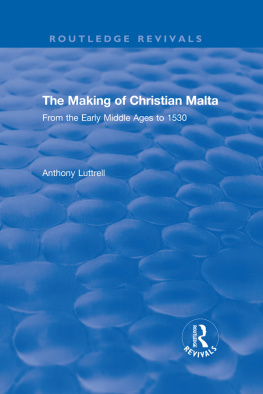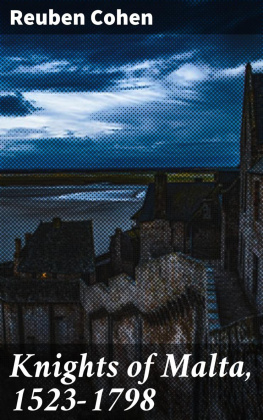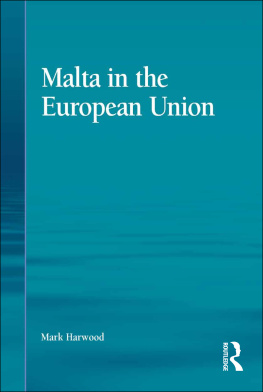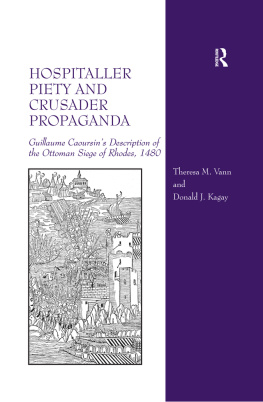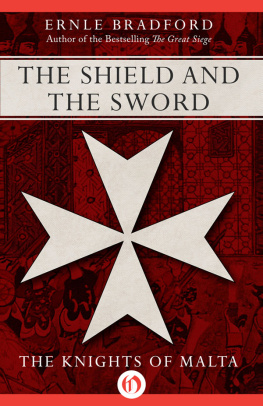Nobility, Faith and Masculinity
Nobility, Faith and Masculinity
The Hospitaller Knights of Malta,
c.1580c.1700
Emanuel Buttigieg
Bloomsbury Academic
An imprint of Bloomsbury Publishing Plc
50 Bedford Square London WC1B 3DP UK | 1385 Broadway New York NY 10018 USA |
www.bloomsbury.com
Bloomsbury is a registered trade mark of Bloomsbury Publishing Plc
First published 2011
Emanuel Buttigieg, 2011
Emanuel Buttigieg has asserted his right under the Copyright, Designs and Patents Act, 1988, to be identified as Author of this work.
All rights reserved. No part of this publication may be reproduced or transmitted in any form or by any means, electronic or mechanical, including photocopying, recording, or any information storage or retrieval system, without prior permission in writing from the publishers.
No responsibility for loss caused to any individual or organization acting on or refraining from action as a result of the material in this publication can be accepted by Bloomsbury or the author.
British Library Cataloguing-in-Publication Data
A catalogue record for this book is available from the British Library.
ISBN: HB: 978-1-4411-0343-7
ePUB: 978-1-4411-7867-1
ePDF: 978-1-4411-0243-0
Library of Congress Cataloging-in-Publication Data
A catalog record for this book is available from the Library of Congress
Contents
The Mediterranean Area. Acknowledgement: Reproduced from The Story of Malta (Malta: Progress Press, 1993), 48, with the kind permission of the author, Brian Blouet.
The Central Mediterranean Area. Acknowledgement: Reproduced from Society, culture and identity in early modern Malta (Malta: Mireva Publications, 2000), xix, with the kind permission of the author, Carmel Cassar and the publisher.
The Maltese Islands. The map denotes some of the key places that will be referred to throughout this study: 1 Valletta; 2 Vittoriosa (or Birgu); 3 Senglea (or l-Isla); 4 Cospicua (or Bormla); 5 Floriana; 6 az Zabbar; 7 Bir Miftuh; 8 Birkirkara; 9 Mdina; 10 Rabat; 11 Mellieha; 12 Rabat (Gozo); 13 Island of Filfla. Acknowledgement: Outline map downloaded from d-maps.com and is here used in line with the published terms and conditions and with the kind permission of Mr Daniel Dalet, webmaster d-maps.com. The URL where the original map comes from is http://d-maps.com/carte.php?lib=malta_map&num_car=2403&lang=en.
Map of Valletta, 1588, engraving, 1814cm. Statuta Hospitalis Hierusalem, 200. Acknowledgement: National Library of Malta. It denotes some of the key places that will be referred to throughout this study: 1 Fort St Elmo; 2 the Holy Infirmary; 3 the Grand Masters Palace; 4 St Johns Conventual Church; 5 the main entrance into the city; 6 St Johns Cavalier; 7 St James Cavalier.
A Note on Currency
In Malta, the Order of St John minted its own currency, called the scudo (pl. scudi). This was the standard silver coin and unit of account: 1 scudo = 12 tari; 1 tari = 20 grani; 1 grano = 6 denari; 2 scudi/1 uncia = 30 tari.
List of Tables and Figures
Tables
3.1 Ranks of the Hospitallers mentioned in the cases analysed at the Archive of the Inquisition of Malta, 15641696.
3.2 Accusations against Hospitallers in the cases analysed at the Archive of the Inquisition of Malta, 15641696.
3.3 Details of prohibited books owned or perused by Hospitallers.
Figures
1.1 Allegory of the virtue of Nobilt, late 1570s/early 1580s.
1.2 A template of a family tree for aspiring Hospitallers, 1658.
1.3 Wolfgang Kilian, Family Tree of a Knight of Malta, 1650.
1.4 The Blessed Gerard serving the sick, accompanied by a novice, 1695.
1.5 Nicholas de Larmessin, after Caravaggio, Grand Master Alof de Wignacourt and page, 1729.
1.6 The Reception of Brothers, 1588.
2.1 On the Master, 1588.
2.2 The Langues of the Order, 1588.
2.3 On both the General and the Provincial Chapters, 1588.
2.4 On the Administration of Commanderies, 1588.
3.1 Allegory of the virtue of Religio, late 1570s/early 1580s.
3.2 On Hospitality, 1588.
3.3 The eight-pointed Hospitaller Cross.
3.4 On the Church, 1588.
3.5 Stefano Erardi (attributed), ex-voto painting, 1685.
3.6 Fr Gabriele Rocchetti Peruginos protective cross, 24 May 1662.
4.1 Pierre Mignard, Commander Fr Jean Jacques de Cordon dEvieu II, c. 1650s.
4.2 Fr Opizio Giudotti, Maltese costumes (detail), c. 1600.
5.1 Wolfgang Kilian, Engraving of the Oratory of St John, 1650.
5.2 On Discarding Brothers, 1588.
5.3 (a) On Prohibitions and Punishments, 1588 and (b) Detail from engraving in Figure 5.3(a).
Acknowledgements
Over the long time-span that it has taken to complete this study, I have incurred many debts. First of all, I would like to thank Mary Laven whose perceptive criticism and suggestions helped to see this work through to the end. I am also grateful to Alexandra Shepard who posed difficult questions that have improved and strengthened the arguments presented in this book. I also need to thank those individuals who read parts or all of this study and commented on early drafts: David Abulafia, Miri Rubin, Ulinka Rublack, Nicholas Davidson, Maria Fusaro, Ann Williams, Michael Deguara and Catherine Tabone. I also thank Catherine for her help with the editing of some of the images that appear in this book and for being such a true friend. I also want to express my gratitude to the two anonymous readers at Continuum for their comments and observations.
A word of thanks must also go to Stefan Cachia, Theresa Vella of Heritage Malta, Josef` Aquilina of the Rehabilitation Projects Office (Malta), Sandro Debono of Heritage Malta, the Bartolo family of Mellieha, Judge Giovanni Bonello, Michael Ward, Antti Matikkala, Sarah Ljubibratic, Diana Carri-Invernizzi, Berthold Kress, Alexandra Bamji, Gemma Betros, Ilya Berkovich, John and Ann Knight of Norwich, Sabrina Camilleri and the Ticino family of Rome, who all helped me in one way or another. Both near and from afar, Tara Alberts, Katherine Linder and Rosienne Farrugia have been close and supportive friends; Tara and Rosienne have also patiently read through the manuscript.


